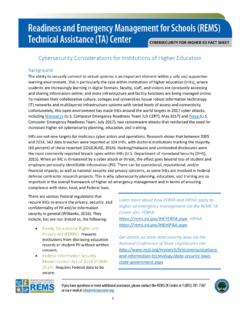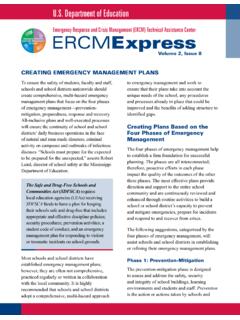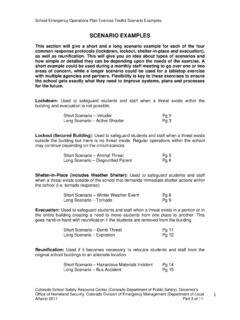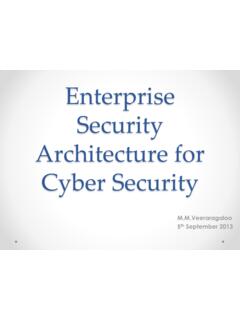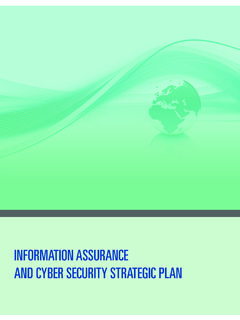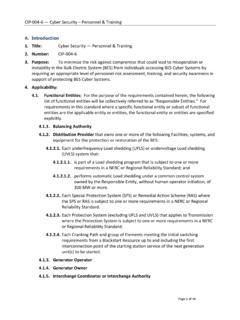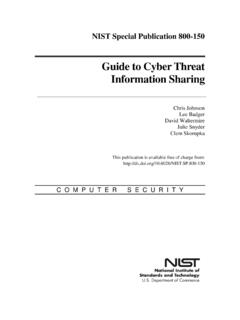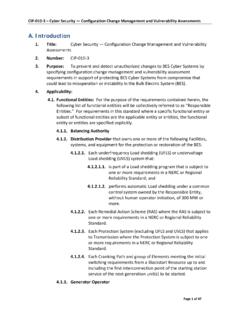Transcription of Cyber Safety Considerations for K-12 Schools and School ...
1 Cyber Safety FOR Schools FACT SHEET Cyber Safety Considerations for K-12 Schools and School Districts The Internet allows for access to information 24 hours a day, 7 days a week. For Schools (public and nonpublic), online capabilities not only create entr e to a vast amount of resources but also facilitate distance learning and collaboration between classes and students in different Along with the benefits the Internet brings, however, come costs such as new threats to students. Recent news articles provide examples of these threats: One man extorted sexually explicit images from minors using social media,i and instances of cyberbullying have reportedly soared in New York City These incidents can lead to depression and anxiety, health complaints, and decreased academic achievement by Some protections for children online are provided by Federal law and regulations, such as the Children s Internet Protection Act (CIPA).
2 Iv CIPA aims to protect children from obscene or harmful content on the Internet. Schools or libraries that are eligible to receive discounts for telecommunications, Internet access, or internal connections through the E-rate program (Universal Service Program for Schools and Libraries) must certify they have an Internet Safety policy that blocks or filters access to pictures that are obscene, child pornography, or harmful to minors. While CIPA may help prevent students from accessing inappropriate content on the Internet, this will not protect students from the full range of online threats. To help address these, information is provided below on the most common online threats facing students and what Schools can do before, during, and after an incident. Cyber Safety AND CYBERSECURITY Cyber threats can impact either the human (students, teachers, and staff) or the physical or virtual ( , information technology [IT] networks and systems) elements of Schools and School districts.
3 While there may be some overlap in addressing human versus physical/virtual threats, preparing for each type can require input from different individuals with experience or expertise on that topic and unique actions before, during, and after an incident. Schools may therefore choose to plan for these threats separately, but still under a broader umbrella of Cyber threats. This fact sheet focuses on addressing threats to people in the School community also called Cyber Safety Considerations . Another fact sheet addressing threats to the School s or School district s network and systems, called cybersecurity, can be found on the REMS TA Center s Website. 1 School refers to all types, including private and public, and all grade levels for the purposes of this fact sheet. 1 Cyber Safety FOR Schools FACT SHEET Online Threats to Students As well as the threats that all users face when going online, such as computer viruses and email scams, students are at risk from the following: Cyberbullying.
4 Cyberbullying is bullying that takes place over digital devices such as cell phones, computers, and tablets. Cyberbullying can occur through SMS, text, and mobile applications (apps) or online in social media, forums, or gaming where people can view, participate in, or share content. Cyberbullying includes sending, posting, or sharing negative, harmful, false, or mean content about someone else. It can include sharing personal or private information about someone else, causing embarrassment or humiliation. Some cyberbullying crosses the line into unlawful or criminal behavior. Inappropriate Content. Adolescents and children can unintentionally come into contact with inappropriate content, such as sexually explicit material. Unsolicited obscene materials can also be received electronically. Sexting. Sexting is the sharing and receiving of sexually explicit messages and nude or partially nude images via text messages or apps.
5 Sexting, while commonly occurring off School grounds, also occurs on School property, with content being sent and viewed on cell phones. Of note is that possession of sexually explicit photos received by sexting can be considered a type of possession of child pornography from a legal perspective. Sextortion/Ransomware. Students may also become victim to sextortion, possibly via ransomware, if they engage in sexting. Sextortion occurs when someone threatens to distribute private and sensitive material if not provided with images of a sexual nature, sexual favors, or money. Ransomware is a particular form of computer malware in which perpetrators encrypt users files, then demand the payment of a ransom for users to regain access to their data. Ransomware can also include an element of extortion, in which the perpetrator threatens to publish data or (possibly sexually explicit) images if the victim does not do what the perpetrator wants, such as provide nude photos.
6 Social media, such as Facebook, Instagram, Snapchat, and Twitter SMS (Short Message Service), also known as Text Message, sent through devices Instant Message (via devices, email provider services, apps, and social media messaging features) Email Most common places where cyberbullying occurs: 2 Cyber Safety FOR Schools FACT SHEET Oversharing. Personal information that is sometimes shared by students includes their name, age, address, phone number, and Social Security number. Online Predation. Online predators put victims through the grooming process, a series of steps by which they build the victim s trust by sympathizing with him or her or feigning common interests, after which they proceed to set up a face-to-face meeting with the victim and then move forward with manipulation and seduction. Preparing for Online Threats to Students Before an Incident Schools and School districts can implement several Cyber policies and procedures to help keep their students safe from online threats.
7 These include the creation and implementation of responsible use policies to ensure that students are aware of appropriate online behavior, the use of filtering and blocking software at School to prevent access to inappropriate content, and education about the risks of being online and how to stay safe. Responsible Use Policies (RUPs) Schools and School districts are encouraged to develop an RUP, also known as an Acceptable Use Policy, before students are allowed to access the Internet at School via a School device or the student s personal device. An RUP is an agreement written in simple and accessible language among parents or guardians, students, and School personnel that outlines the terms of responsible use and consequences for misuse. Families are usually expected to acknowledge that their child(ren) will follow basic guidelines, and students agree to the standards laid out in the policy.
8 RUPs can cover issues such as expectations for online behavior, what resources can be accessed, academic integrity when using technology, and how student data and information will be used by the School . For example, the New York City Department of Education s Internet Acceptable Use and Safety Policy provides a summary of the policy including a hyperlink to an easy-to-read description for parents/guardians, teachers, and students and principles for use, such as monitoring, privacy, prohibited uses of the Internet systems, and filtering, among Filtering and Blocking Content One of the first ways to prevent students from accessing inappropriate content either deliberately or accidentally is for Schools and School districts to use filtering and blocking 3 Cyber Safety FOR Schools FACT SHEET software, which allows users access to only preapproved Websites.
9 Teachers and staff can help determine what sites should be blocked. Regular audits can also be conducted to ensure that appropriate online educational material can still be accessed and to determine if blocked sites should remain blocked. Digital Citizenship Schools and School districts are also encouraged to teach students what it means to be a responsible digital citizen as part of a broader strategy of promoting a positive School climate. A digital citizenship curriculum can include topics such as privacy and security, relationships and communication, cyberbullying and digital drama, digital footprints and reputation, self-image and identity, information literacy, and creative credit and copyright. As an example of a digital citizenship curriculum used by the K-12 School community, the Jurupa Unified School District educates students in Internet Safety , privacy, relationships, cyberbullying, self-image, copyright rules, and other Lessons are age appropriate, and discussions change depending on the latest digital trends and include topics such as the importance of making only constructive comments online.
10 Education and Training Students, teachers, staff, and families can also be educated on online Safety . Three sources of information are the following: 1. Campaign ( ; Department of Homeland Security) is a national awareness campaign that provides resources such as videos, a toolkit, and blogs to help raise the awareness of Cyber threats and how to be safer online. 2. NetSmartz Worskhop ( ; National Center for Missing and Exploited Children [NCMEC]) provides resources for parents and guardians, educators, and law enforcement with the goal of educating, engaging, and empowering children to recognize potential Internet threats, talk to adults about risks, prevent themselves from being exploited, and report victimization to adults. Separate Websites and resources are available for kids, tweens, and teens. 4 Cyber Safety FOR Schools FACT SHEET 3.
